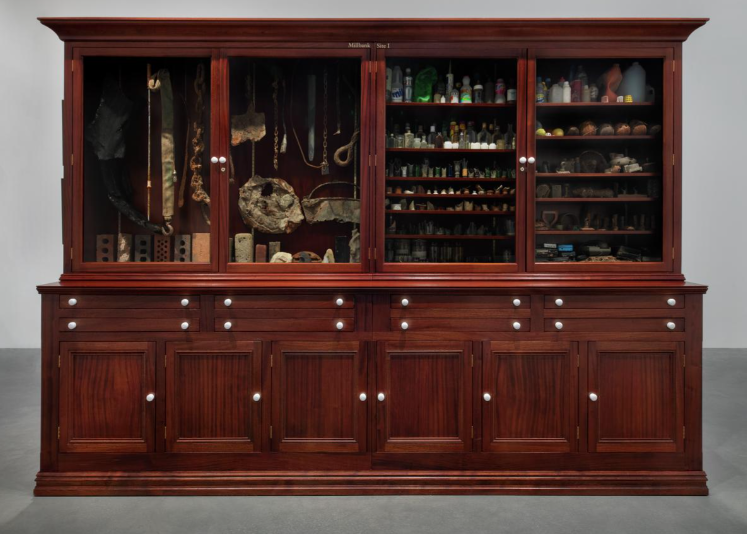Content/Structure/Clarity:
-
- I commend your citation of Bilbao’s concept in Blog 1, utilising Zarina Bhimji’s artistic work as an example to elucidate how small-scale artistic ventures (SAVOs) offer a more relaxed atmosphere compared to large-scale biennials through the utilisation of colour and light to visually stun the audience.This, in my view, underscores SVAOs’ heightened focus on spatial relationships between presentation methods and the audience [1]. However, SVAOs concurrently possess unique methods of engaging with the public that transcend exhibition production. For instance, The Showroom’s project in London [2] enriches diverse interactions by establishing the penfold medicinal garden.
- In your blog 3, you adeptly employ Smith and Leonari’s theory to assert audience participation as a pivotal curatorial factor. I argue that beyond audience engagement, there exists a greater emphasis on collaboration derived from communities espousing values rooted in community-based infrastructural activism [3]. Further elaboration on the CCA’s Seed Library project [4] could serve to illustrate this point.
- Your adept interpretation of Hou’s concept regarding the direct elicitation of potent emotions through scent, as exemplified by the Tate Sensorium case in Blog 9, is commendable. It would be beneficial to delve into specific sensory modalities, such as the juxtapositional treatment of sound in works like “In the Hold.”. Yusoff also posits the reshaping of themes through sensory experiences [5], wherein art becomes a novel mode of adapting to reality [6].
- Francis Bacon’s “Figure in a Landscape” (1945) interpreted through edible charcoal, sea salt, cacao nibs, and smokey lapsang souchong tea by Paul A. Young. TATE.
Individual Project:
-
- Personal Recommendations: In discussions within blogs 5, 7, and 8 concerning individual projects exploring abandonment, decay, and rejuvenation in derelict industrial spaces, I suggest referencing Pierre Nora’s “Places of Memory,” which delves into the relationship between individuals and places, as well as Torgeir’s “Industry Heritage and the Ideal of Presence,” which explores the transformation of industrial derelict sites into cultural landmarks or artistic spaces.
- Since the mid-twentieth century, abandoned structures have engendered atmospheres ripe for exploration, with audience involvement being imperative [7]. Consider incorporating audience participation into this project.
- Regarding the selection of artworks, the salvaging and therapeutic potency of archaeological material interventions are noteworthy [8], such as Mark Dion’s “Tate Thames Dig” [9].
- © Estate of Francis Bacon. All Rights Reserved, DACS 2024. License this image. In Tate Modern. Francis Bacon (1909–1992), Oil on canvas, Support: 1448 × 1283 mm, Frame: 1628 × 1464 × 120 mm, Tate, 1950 (N05941).
Rigour:
- In blog 7, your assertion regarding the novel presentation of African art classification transcending historical boundaries embodies a method of intertwining the present, past, and future, stretching the confines of archives [10], to comprehend the present and invent the future [11]. You could talk about how art exhibitions can lead to more fair conversations, using Derrida’s theory of archive fever [12] to look at the unstable and contradictory nature of archives. You could also look at things from the point of view of museum information credibility, like how the American museum secrecy regime protects knowledge while strengthening existing power structures [13], to find ways to be more fair.
- You also need to cite two or more specific works that demonstrate ‘nonnormative time’.
- In blog 8, you separately mention how site-specific art can uncover marginal locales. I propose including corresponding artworks for discussion, such as the “Münster Sculpture Project,” initiated in 1997 [14]. Your mention of “The Floating Piers” as extensions of streets increasing interactivity also reflects “media specificity” [15].
- Untitled (Sculpture for Chemical Institutes), 1987, consists of 35 black sandblasted granite slabs, each 150 x 150 cm, arranged in a 7 x 5 panel formation, measuring 1050 x 750 cm, at LWL-Museum für Kunst und Kultur, Münster.
Design
- Each article has supporting theoretical citations, corresponding visual images, readable fonts, and unambiguous layouts. Additional information could be added to the images in Blog 1 to enhance respect for intellectual property rights.
Notes contain theoretical books and relevant cases for reference only.
Notes:
[1] Bilbao Yarto, Ana Edurne. Micro-Curating : The Role of SVAOs (Small Visual Arts Organisations) in the History of Exhibition-Making. 2018.
[2] “Communal Knowledge.” The Showroom, www.theshowroom.org/programmes/communal-knowledge.
[3] Fisher Jennifer. (2017) Jeremy Shaw’s DMT. Performance Research, 22 (6), 43 https://doi-org.ezproxy.is.ed.ac.uk/10.1080/13528165.2017.1412648
[4] “Glasgow Seed Library.” CCA Glasgow, www.cca-glasgow.com/projects/glasgow-seed-library.
[5] Yusoff, Kathryn. A Billion Black Anthropocenes or None / Kathryn Yusoff. University of Minnesota Press, 2018.
[6] Davis, Heather, and Etienne Turpin. Art in the Anthropocene : Encounters Among Aesthetics, Politics, Environments and Epistemologies. Open Humanities Press, 2015, https://doi.org/10.26530/OAPEN_560010.
[7] Thea, Carolee., and Thomas. Micchelli. On Curating : Interviews with Ten International Curators / by Carolee Thea. First edition., D.A.P./Distributed Art Publishers, 2009.
[8] Gavin Lucas. “Models of Production and Consumption.” Archaeologies of the Contemporary Past. Routledge, 2001. 33–37. Web.
[9] Tate. “‘Tate Thames Dig’, Mark Dion, 1999.” Tate, 1 Jan. 1999, www.tate.org.uk/art/artworks/dion-tate-thames-dig-t07669.
[10] Venus in Two Acts, pp. 12, 11. warwick.ac.uk/fac/arts/history/research/centres/blackstudies/venus_in_two_acts.pdf.
[11] Laura McMahon, Disordering archives: Onyeka Igwe and Black feminist speculative histories, Screen, Volume 64, Issue 4, Winter 2023, Pages 377–400, https://doi.org/10.1093/screen/hjad036
[12] Falls, Catherine MacArthur. “Installation Art and the Practices of Archivalism by David Houston Jones (Review).” Archivaria 83.1 (2017): 149–153. Print.
[13] Current Anthropology , December 2015, Vol. 56, No. S12, Supplement 12: The Life and Death of the Secret (December 2015), pp. S263-S275
[14] “Matt Mullicans ‘Untitled (Sculpture for The Chemical Institutes)’ (1987) at Its New Site.” Skulptur Projekte Archiv, skulptur-projekte-archiv.de/.
[15] Kwon, Miwon. “Unhinging of Site Specificity.” One Place after Another. United States: MIT Press, 2002. Web.



